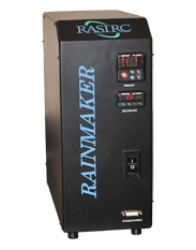Steam purification company RASIRC has declared that it has presented a poster on the benefits of water vapor utilization over ozone in the atomic layer deposition (ALD) process at the 26th European Photovoltaic Solar Energy Conference and Exhibition conducted in Hamburg, Germany, from September 5 to 9, 2011.
The poster presentation titled ‘Water Vapor Versus Ozone for the Growth of ALD Films’ has also provided the results of experiment conducted by researchers in Dresden, a Germany-based Fraunhofer Institute. According to the results, the utilization of water vapor demonstrated quicker growth rates compared to ozone.
 RainMaker Humidification System (RHS
RainMaker Humidification System (RHS
During the test of 100 ALD cycles of trimethyl aluminum (TMA)/ozone and TMA/water precursors, the growth rate of water vapor was 10.25 Å/cycle, while that of ozone was 0.9 Å/cycle. The water vapor’s growth rate was 14% quicker than ozone and it produced below 40 particles in a haphazard pattern, which is this process’ characteristic.
The ultrapure water vapor was produced by RASIRC’s RainMaker humidification system (RHS) that produces accurate quantities of ultrapure water free from dissolved gases and ionic contaminants. It can introduce precise quantities of ultrapure water vapor straightaway into any type of carrier gas stream. RASIRC products provide ultrapure water vapor for applications such as semiconductor, nanotechnology, photovoltaics and more.
RASIRC’s Founder and President, Jeff Spiegelman stated that passivation layers are a critical component for future-generation crystalline solar cell devices and ALD is one of the technologies used for the growth of Al2O3 films. The company’s poster describes that ALD layers can be efficiently developed utilizing water vapor in place of ozone, which is hazardous, costlier and equipment intensive, he said. ALD’s commercial acceptance is limited by its slow growth rate and the substitution of ozone with water vapor due to its quicker growth rate facilitates commercialization of ALD, he added.